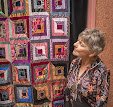Going Down South
 On a trip down to Cheshire, to talk to Cranford Quilters, I found I was staying overnight within spitting distance of the famous Jodrell Bank observatory. It makes an excitingly space-age impact as it looms out of the autumnal landscape, at first appearing strange and obtrusive. But after a few hours, walking in the surrounding lanes, viewing it from different angles, it acquires a mysterious elegance and, eventually, comes to seem a completely appropriate part of the scene.
On a trip down to Cheshire, to talk to Cranford Quilters, I found I was staying overnight within spitting distance of the famous Jodrell Bank observatory. It makes an excitingly space-age impact as it looms out of the autumnal landscape, at first appearing strange and obtrusive. But after a few hours, walking in the surrounding lanes, viewing it from different angles, it acquires a mysterious elegance and, eventually, comes to seem a completely appropriate part of the scene.
This part of rural Cheshire is very much Manchester commuting country - going on foot in the lanes is hazardous as high-spec cars race along at speed bearing the well-heeled business persons home to their newly-built country mansions.
But not all the local residents are like this: I was staying with people who live in an eighteenth century farmhouse with surrounding fields which are run as a smalholding - they produce all their own meat (from pigs, lambs, a few beef cattle) fruit and vegetables. Being offered this sort of food reminds me of what we miss most of the time, unless we go to a local farmers' market.
Cranford Quilters is a very friendly and active group and we had a stimulating evening, with some good Show and Tell and me giving my Islamic Arts and Crafts talk and showing quilts inspired by the Moorish patterns I'm so fascinated by. Altogether, despite the hair-raising drive down the M6 - unrelenting torrential rain, bumper-to-bumper commercial traffic, road works causing tail-backs three miles long - I had a great time and felt that the visit more than justified the journey. Anyway, by contrast, the return drive was a doddle, with the Motorway behaving as it should in fine, dry conditions.

2 comments:
C, have you read T. Burckhardt's book on the Moors? Not his best, but quite good nevertheless. I hope you put up some pictures of Islamic patterns and say a few words on them.
" [Islamic art contains } a unique unity of form which maintains itself over centuries"
Titus Burkhardt. Art of Islam. Language and Meaning.
Burkhardt was so overwhelmed by what he found at the Alhambra that he spent three years there producing his book. I've read it,but haven't actually managed to get my own copy yet.He's extensively quoted in several of the other books I've got on the subject.
I'll certainly get some illustrations and captions up, although I'm painfully conscious of the fact that, in approaching this subject of Islamic pattern I'm dabbling in very deep spiritual and academic waters. I know that my own knowledge and understanding are superficial, much as I try to study and learn more.
But I do try, in so far as I can understand them myself, to make people aware of the underlying philosophical and religious significance.
Interpreting these patterns in textiles seems almost sacriligious, yet it's done from a deep sense of awe and a never-ending excitement at their infinite graphic possibilities. Patchwork and the Spirit of Geometry, indeed!
Post a Comment